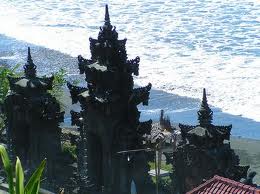Nyepi is derived from the word sepi (lonely, silent). Nyepi Day is actually a celebration of New Year according to Hindu calendar / Saka calendar, which began in 78 AD. Unlike common New Year celebrations , Saka New Year in Bali starts with solitude. No activity as usual. All activities were eliminated, including public services, such as the International Airport was closed, but not for hospitals.
The main purpose Nyepi is pleading before God Almighty, to purify Buwana Alit (natural human / Microcosmos) and Buwana Agung / macrocosmos (the universe). Before Nyepi, there are several series of ceremonies performed Hindus, particularly in the area of Bali.
Melasti
Melasti
Three or two days before Nyepi, the Hindu people perform purification ceremonies also called Melis or Melasti or Mekiyis. On that day, all the existing means of praying in the temple (shrine) in procession to the beach or lake, as the sea or lake is the source of holy water (Tirta Amrita) and can purify all leteh (gross) in man and nature.
Tawur (Pecaruan), and Pengrupukan
The day before Nyepi, namely the "tilem sasih Kesanga" (the deadmoon in the 9th month), Hindus people perform ritual Bhuta Yadnya at all levels, from individual families, train, village, district and beyond, by taking one of the types caru (sort of offerings) according to his ability. Bhuta Yadnya it is an effort to neutralize the natural, calming bhuta or negative force with a sacrifice in the form of sajen caru.
It is intended that when implementing Nyepi Day of negative forces do not interfere until the new year and beyond.
ogoh-ogoh
Caru Tawur Kesanga followed by a ceremony Pengerupukan, the time when everything will be noisy and crowded, torching home area and around the yard, and to strike any objects (usually kentongan) to speak crowded / noisy. This stage is performed to drive out of the home environment Buta Kala, yards, and the environment. Lodging in Bali, pengrupukan is usually celebrated with a ogoh-ogoh parade, that is the personification of Buta Kala and paraded around the neighborhood, and then burned. The goal at the Buta Kala or repel negative forces from the surrounding environment.
Hari Raya Nyepi
atmosphere of the city on Nyepi Day
The next day, ie on pinanggal pisan sasih Kedasa (first day of 10th month), it was the real Nyepi. In today's atmosphere like a death. There is no rush as usual activities. On this day Hindus perform "Catur Brata" Penyepian which consists of amati geni (no use and or turn on the fire), amati karya (not working), amati lelungan (not traveling), and amati lelanguan (not looking for any entertainment). And for those who can also carry out tapa, Brata, yoga and semadhi.
So for the new, completely new start with a clean white page. To start a new life in the years Caka, basis is used, so that everything we do begins with nothing, pure and clean. Each of the relegious man (the wruhing tattwa Jnana) implement Brata (curbing the passions), yoga (connecting people with paramatma (God), Tapa (exercise endurance suffering), and contemplation (united to God, the end goal is the sanctity of both inner and outer).
All of it becomes imperative for Hindus to have an inner readiness to face any challenge life in the new year.
Ngembak Geni
The last series of the Saka New Year celebration is a day that falls on "pinanggal kalih" (date 2) sasih kedasa (X months). On this day the Saka New Year for a second day. Hindus did Dharma Shanti with a large family and neighbors, give thanks and sorry forgive each other (ksama) one another, to begin a new year a clean sheet. Dharma Santi is a core philosophy that sees Tattwamasi that all human beings all over the world as the creation of Ida Hyang Widhi Wasa should love each other one another, forgive any mistakes and errors. Live in harmony and peace.










